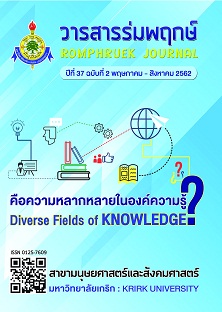The Indicators of Thai Television Entertainment Reporter Professionalism
Main Article Content
Abstract
This research was a qualitative research. Its objectives were to 1) analyze the professionalism of Thai television entertainment reporters in the opinion of persons involved, and 2) construct the indicators of Thai television entertainment reporter professionalism. The key informants for this research were consisted of two groups. The first group consisted of twelve experts in communication field as follows 1) managers or editors of Thai television entertainment reporters 2) persons from practitioner level of Thai television entertainment reporters 3) Communication Arts or Journalism and Mass Communication academicians. The data received from the in-depth interviews of these experts were collected. The second group of informants consisted of seventeen experts in communication fields, these were: 1) managers or the editors of Thai television entertainment reporters, 2) persons from practitioner level of Thai television entertainment reporters, and 3) the Communication Arts or Journalism and Mass Communication academicians. This group of experts also received the in-depth interviews, and the data were collected. Then, the two sets of data were measured twice for consensus using the Delphi technique. As a result, the indicators of Thai television entertainment reporter professionalism were received. After that, the analysis of Thai television entertainment reporter professionalism indicators was conducted. The research instrument was an open-ended questionnaire of five point rating scale. The data received were analyzed using the percentage, mean, median and interquartile range.
The results showed that the indicators of Thai television entertainment reporter professionalism consisted of six areas, for the total of thirty-five indicators: knowledge with 6 indicators; communication skills with 3 indicators; language skills with 7 indicators; personality with 9 indicators; ethics and morality with 6 indicators and work-related technology & equipment with 4 indicators. In addition, the indicator that was highly in accordance with the expert opinions and received the highest score was the adherence to the principle of verifiable fact (=4.88). The next indicator that received the second high score was the integrity in their job (=4.82).
Article Details
Every article published in the Romphruek Journal of the Humanities and Social Sciences is the opinion and point of view of the authors. Thery're not the viewpoint of Krirk University or the editored department. Any part or all of the articles for pablication must be clearly cited.
References
กาญจน์ ทันจิตต์. (2552). การนำเสนอข่าวการแยกทางของดาราและปฏิกิริยาของผู้เกี่ยวข้อง.
คณะนิเทศศาสตร์ จุฬาลงกรณ์มหาวิทยาลัย, กรุงเทพฯ.
เฉลิมพล ไวทยางกูร. (2561). ความน่าเชื่อถือของสื่อทีวี. (23 เมษายน 2562) สืบค้นจาก
https://www.bangkokbiznews.com/blog/detail/644489.
ณรงค์วิทย์ แสนทอง. (2547). มารู้จัก Competency กันเถอะ. กรุงเทพฯ : เอชอาร์เซนเตอร์.
ณัฐฐวัฒน์ สุทธิโยธิน. (2548). การสร้างสรรค์รายการข่าวโทรทัศน์ หน่วยที่ 7 การสร้างสรรค์รายการโทรทัศน์.
คณะนิเทศศาสตร์ มหาวิทยาลัยสุโขทัยธรรมาธิราช, กรุงเทพฯ.
เทียนทิพย์ เตียวกี่. (2559). จริยธรรมและจรรยาบรรณในการนำเสนอข่าวสารยุคดิจิตอล. วารสารการสื่อสารและการจัดการนิด้า, 2(2).
ธามเชื้อ สถาปนศิริ. (2558). พหุทักษะ (Multi Skill) สำหรับคนทำข่าวในยุคดิจิทัล. (25 มีนาคม 2562) สืบค้นจาก https://www.facebook.com/photo.php? fbid=10153311379128732&set=a.483861243731.261519.720008731&type=3&theater.
บุญอยู่ ขอพรประเสริฐ. (2551). ดัชนีชี้วัดความเป็นวิชาชีพของผู้สื่อข่าวการเมืองไทย.
คณะวารสารศาสตร์และสื่อสารมวลชน มหาวิทยาลัยธรรมศาสตร์, กรุงเทพฯ.
ปัญญาลักษณ์ ศรีบุรินทร์. (2555). การสัมภาษณ์แหล่งข่าว. (28 มีนาคม 2562) สืบค้นจาก
https://www.slideshare.net/sriburin/ss-12943220.
พรรณพิมล หล่อตระกูล. (2553). โครงการศึกษาเฝ้าระวังสื่อและพัฒนาการรู้เท่าทันสื่อเพื่อสุขภาวะของสังคม(Media Monitor).
(16 มีนาคม 2562) สืบค้นจาก http://www.familynetwork.or.th./node/244.
พิศิษฐ์ ชวาลาธวัช. (2546). การรายงานข่าวขั้นสูง. กรุงเทพฯ : สำนักพิมพ์ดอกหญ้า.
พัชรินทร์ รักสัตย์. (2560). กระบวนการสื่อข่าวของรายการข่าวบันเทิงทางโทรทัศน์ในยุคหลอมรวมสื่อ.
คณะนิเทศศาสตร์ มหาวิทยาลัยกรุงเทพ, กรุงเทพฯ.
มนัสนันท์ อภิรมย์วิจิตร. (2554). ปัจจัยที่มีอิทธิพลในการเปิดรับชมรายการข่าวบันเทิงของประชาชนทั่วไปในเขตกรุงเทพมหานคร. คณะวารสารศาสตร์และสื่อสารมวลชน มหาวิทยาลัยธรรมศาสตร์, กรุงเทพฯ.
มานะ ตรีรยาภิวัฒน์ และ กนกกาญจน์ บัญชาบุษบง. (2559). พฤติกรรมการรับข่าวสารและความเชื่อมั่นของประชาชนที่มี
ต่อสื่อมวลชน. (27 มีนาคม 2562) สืบค้นจาก http://www.utcc.ac.th/index.php/th/news/Prnews_detail/6005.
Tv Digital Watch. (2562). เรตติ้งทีวีดิจิตอล. (3 เมษายน 2562) สืบค้นจาก https://www.tvdigitalwatch.com.
วศิน บุณยาคม. (2562). รักษาการผู้จัดการส่วนบริหารผังรายการฝ่าย 9MCOT HD, สัมภาษณ์. 2562.
วิภา ปิ่นแก้ว. (2554). จริยธรรมการนำเสนอรายการเล่าข่าวบันเทิงของสถานีโทรทัศน์ผ่านดาวเทียม.
คณะวารสารศาสตร์และสื่อสารมวลชน มหาวิทยาลัยธรรมศาสตร์, กรุงเทพฯ.
ศศินา วิมุตตานนท์. (2561). เตรียมพร้อมเป็นผู้ประกาศข่าว - นักจัดรายการวิทยุมืออาชีพ. (21 มีนาคม 2562) สืบค้นจาก http://www.weloveshopping.com/shopshow_article.php?shopid=5163&qid=13400.
ศิวนารถ หงส์ประยูร. (2550). ตระกูลข่าวโทรทัศน์ในประเทศไทย. คณะนิเทศศาสตร์จุฬาลงกรณ์มหาวิทยาลัย, กรุงเทพฯ.
สกุลศรี ศรีสารคาม. (2554). สื่อสังคม (Social Media) กับการเปลี่ยนแปลงกระบวนการสื่อข่าว.
คณะนิเทศศาสตร์ มหาวิทยาลัยธุรกิจบัณฑิตย์, กรุงเทพฯ.
สุกัญญา สุดบรรทัด. (2537). จริยธรรมสื่อมวลชนไทย กรณีศึกษาเพื่อการเรียนการสอนส่งเสริมคุณธรรมจริยธรรมสื่อมวลชนไทย. กรุงเทพฯ : สำนักพิมพ์จุฬาลงกรณ์มหาวิทยาลัย.
สุปราณี ศีริสวัสดิ์ชัย ชเนตตี ทินนาม และ ต่อตระกูล อุบลวัตร. (2557). ดัชนีชี้วัดความเป็นวิชาชีพของผู้ประกาศไทย.
คณะนิเทศศาสตร์การสื่อสารมวลชน มหาวิทยาลัยราชภัฏบ้านสมเด็จเจ้าพระยา, กรุงเทพฯ.
สุรสิทธิ์ วิทยารัฐ. (2552). ข่าวบันเทิงที่สร้างสรรค์แรงบันดาลใจ. (27 มีนาคม 2562) สืบค้นจาก
http://www.tja.or.th/index.php?option=com_content&view=article&id=283%3A2009-09-08-11-05-16&catid=46% 3Aacademic.
อาภารดี บุญเฉลย. (2553). บทบาทการนำเสนอเนื้อหาข่าวกับปัญหาจริยธรรมของปาปารัซซี่ กรณีศึกษานิตยสารกอสซิบสตาร์.
คณะนิเทศศาสตร์ มหาวิทยาลัยธุรกิจบัณฑิตย์, กรุงเทพฯ.
อุษา บิ๊กกิ้นส์. (2555). การรู้เท่าทันสื่อและสารสนเทศ. สุทธิปริทัศน์, 26(80), 147-162.
Boyatzis, R. (1982). ผู้นำที่ทรงพลัง. กรุงเทพฯ : เอ็กซเปอร์เน็ท.
Edmund Lambeth. (1992). Committed journalism : An Ethic for the Profession. Indiana : U. Press.
Fisher, Walter. (1984). Narration as Human Communication Paradigm : The case of Public Moral Argument. Joural Communication Monographs, 51(1).
Irving Fang. (1974). School of Journalism and Mass Communication. London : Television News.


